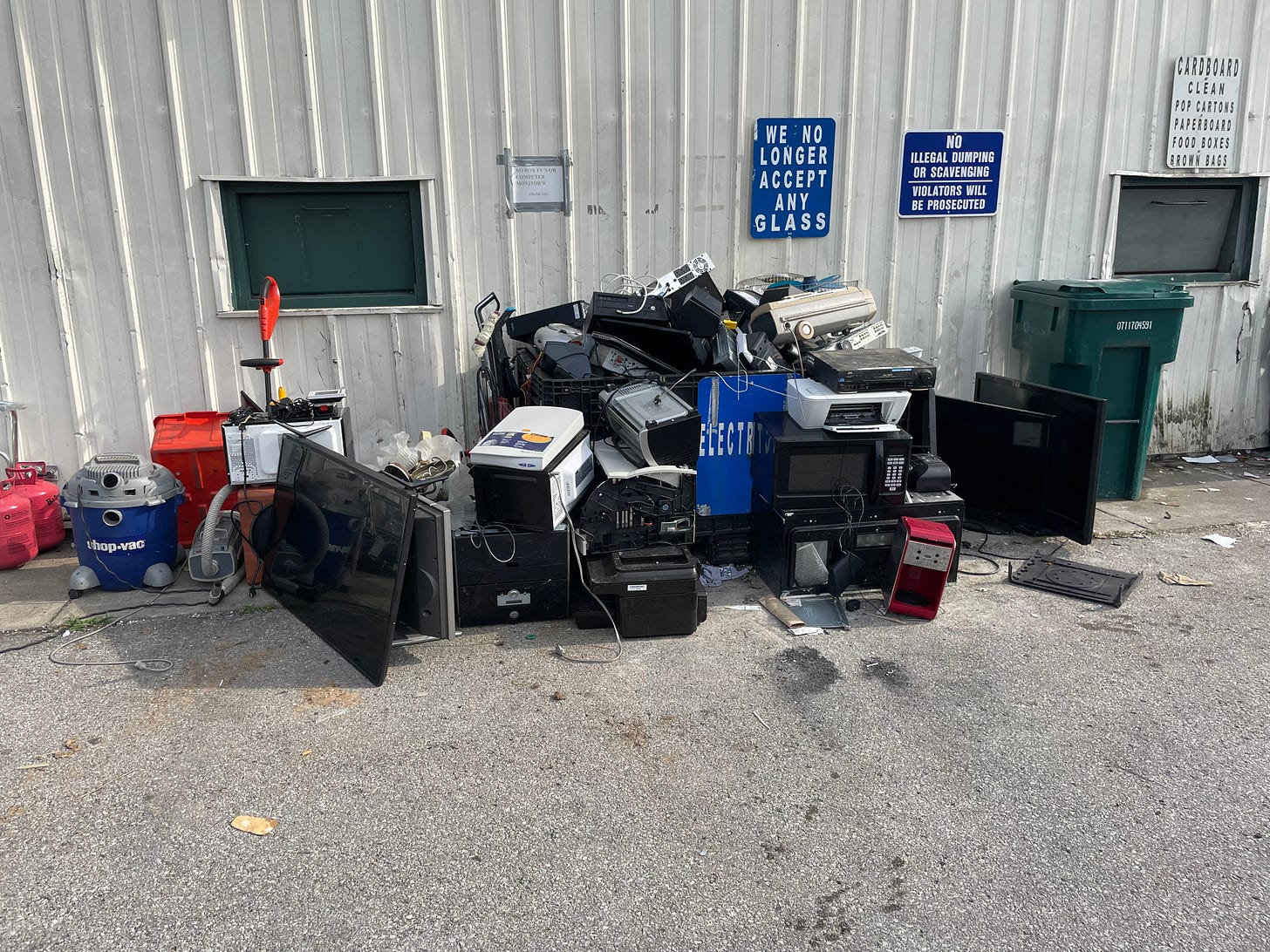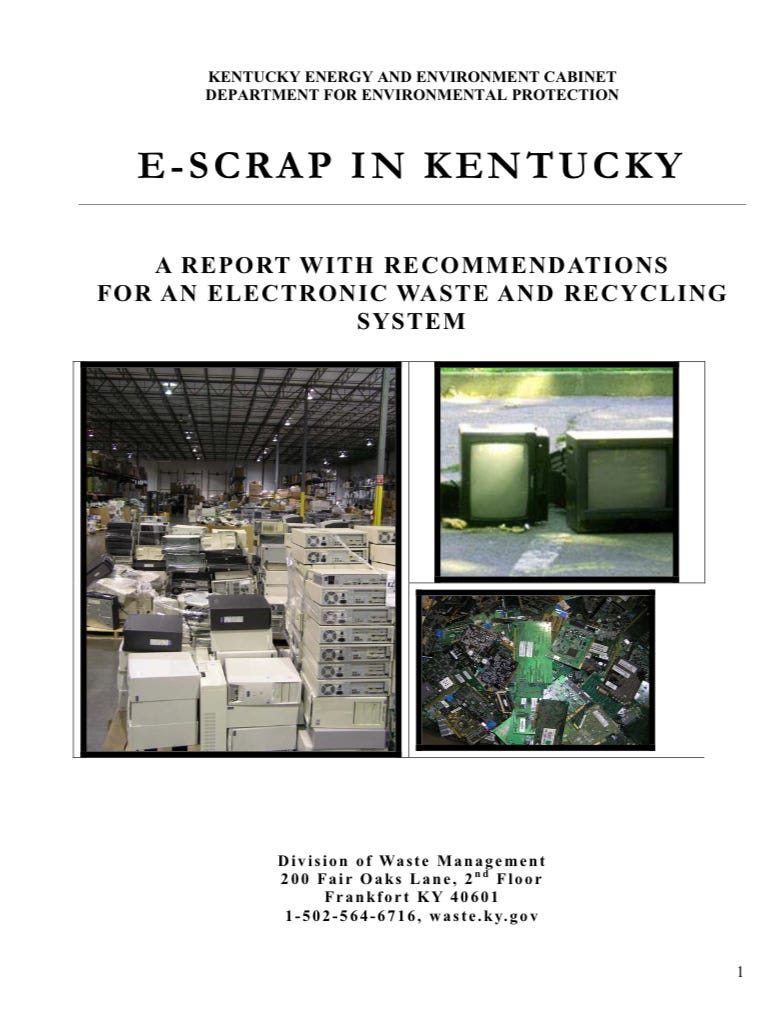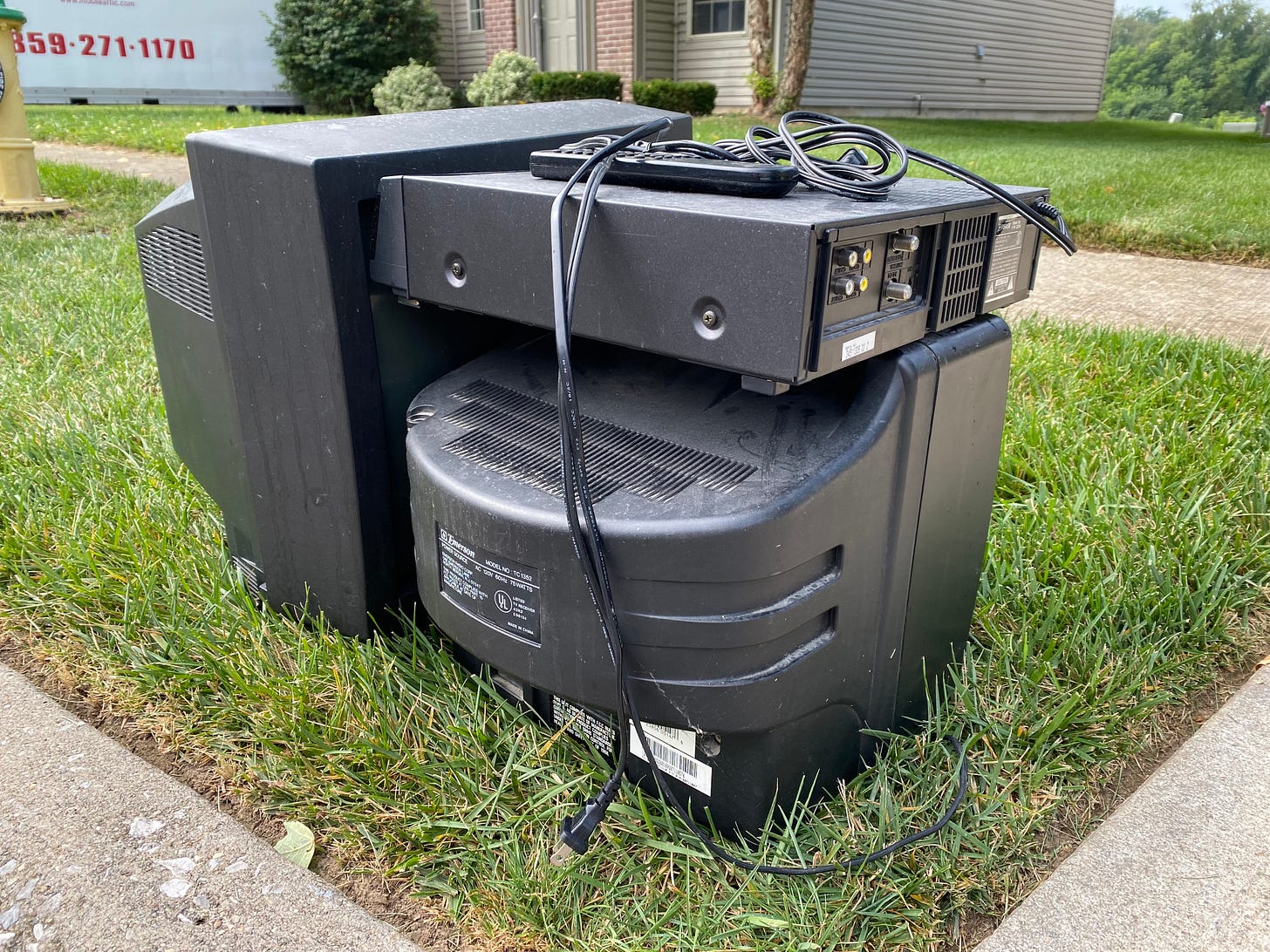When Will Kentucky "Log On" and Take Electronic Waste Seriously?
Despite having long-term detrimental impacts on humans, animals and the environment, "e-waste" remains on the public health backburner.
As humans find an ever-increasing number of ways to stay plugged in and connected, electronic waste—which includes everything from discarded computers and televisions, to tossed-out toasters and hot plates—will continue to be the fastest growing waste revenue stream in the world, as well as one of the most dangerous. “E-waste” or “e-scrap”, as it's more colloquially known, has been proven to have long-term detrimental health impacts on humans, animals and the land itself due to the presence of heavy metals like lead and mercury, as well as chemicals like Perfluorooctanoic acid (PFOA) and Brominated Flame Retardants (BFRs). By 2030, the global annual total for e-waste is projected to be 75 million tons: almost doubling the current yearly amount.
Mercury is used in computer monitors and fluorescent lighting, but exposure to it can cause brain damage. We estimated that about 50 tons of mercury is contained in these undocumented flows of e-waste that end up in the environment each year.
E-waste doesn’t just pose a health risk though. It also contributes directly to global warming. Dumped temperature-exchange equipment, found in fridges and air conditioners, can slowly release greenhouse gases. About 98 million tons are thought to leak from scrapyards each year, equivalent to 0.3% of global emissions from the energy sector. –“Global electronic waste up 21% in five years, and recycling isn’t keeping up”, The Conversation, July 2020
In response to this novel waste crisis that continues to morph and evolve, communities across America have gotten increasingly serious about developing state and local-level programs to address hazardous e-waste in their areas, whether through outright bans on tossing out e-scrap in landfills, recycling efforts, buyback programs or monetary credits toward future recycling at the time of electronic purchase. 25 states to date currently have some form of regulations surrounding e-waste.
But not Kentucky.
(Pile ‘o electronic waste at the Richmond City Recycling Center, Madison County, June 2021)
Despite understanding the harmful impact that electronic waste poses, Kentucky law still currently allows for it to be disposed of in landfills like any run-of-the-mill household waste, and has offered little-to-no guidance for the general population about the best ways to recycle or reuse these electronic items (not to mention why it’s so pressingly important).
“Electronic waste and electrical products in homes are not currently regulated or banned from landfill disposal in Kentucky. This means that households may legally dispose of electronic equipment, such as home computers and monitors, in their garbage, provided that your garbage collector and landfill will accept it,” reads the e-scrap page of the Kentucky Energy and Environment Cabinet’s environmental protection website. “However, the Division of Waste Management strongly encourages responsible management of electronic equipment through recycling.”
How can citizens figure out a way to recycle, reuse or—er, “responsibly manage”—their e-scrap when there’s no clear direction from state leaders about the need to do so, and it’s a challenge to figure out where to make that happen locally, particularly in rural areas? A look into a state-produced list of e-scrap recyclers even proved to contain a great deal of incorrect information. (More on that later.)
But first, a little background on legislative attempts to manage electronic waste in Kentucky.
The first, and only significant, legislative action addressing public e-waste in Kentucky happened in 2008, around the same time that many states across the country were attempting to write policy that would get a handle on this newfangled pollution stream. Denise Harper Angel of Louisville’s 35th District introduced, and was able to successfully pass, a joint resolution instructing what was then called the Environmental and Public Protection Cabinet to, “submit a report containing recommendations for an electronic waste disposal and recycling system” to the Legislative Research Commission.
That report, from all indications on my end, has been essentially buried for 13 years—which is a shame because it has some sharp policy recommendations that could’ve been enacted over a decade ago. When I asked John Mura, Executive Director for the Office of Communication at the EEC, about locating it, he replied via email, “Gary Logsdon, our recycling manager, said the cabinet had a previous request for this report and it could not be located.”
With a little help from the Legislative Research Commission, though, it was fairly simple to find, and I’ve made it available here to read in full. Among the recommended steps, many mirror those of states that passed laws in the late 2000s, but still haven’t been touched by Kentucky. Among others, these include:
The Legislature should consider requiring e-scrap recyclers to obtain a financial mechanism in the event that their activities result in releases or threatened releases of hazardous wastes to the environment. These would be requirements to remain registered to do business in Kentucky. Registration and proof of insurance should be reported in two years of any statute taking effect.
A producer registration program should be instituted, requiring manufacturers, retailers, and resellers to indelibly brand their products, report those brands to the Energy and Environment Cabinet and sell only those brands in the Commonwealth.
Three years after an e-scrap management statute takes effect, e-scrap—at minimum, video displays of four-inch diagonal measure and above, including mobile (cell) phones—should be banned from landfills in the commonwealth.
But the state didn’t follow up on these recommendations—or give serious though to more progressive overhauls. Instead of creating a robust, statewide program with multiple stakeholders, public facing education and a clearly defined access system, they focused almost exclusively on e-waste recycling within state government itself.
Today, Powerhouse Recycling out of Salisbury, North Carolina handles the electronic waste for Kentucky’s executive branch. And while the EEC is always quick to point out that any universities, municipalities or other government branches can also sign on to contract with Powerhouse, in many ways, this continues to pass the buck on actual large-scale efforts.
(Friday, I’ll trace some background about Kentucky’s previously dicey history with electronic waste contractors as well as a full interview with Garrett Powell, Powerhouse’s representative in Kentucky, for paid subscribers. Sign up here to read!)
“Energy and Environment Cabinet Secretary Rebecca Goodman understands that responsibly managing e-scrap is an integral part of protecting the environment. Kentucky has a statewide contract for managing e-scrap generated by state government,” reads an EEC statement provided to me on the issue. “This contract can also be used by counties, school districts, universities and other governmental entities. Under that contract, 404,733 pounds of e-scrap were collected for recycling in 2020."
The statewide contract has been very beneficial and the cabinet’s Household Hazardous Waste Grant program can be used by counties to help manage e-scrap as well. With some counties and other government entities choosing to manage their e-scrap on their own under separate contracts, the cabinet does not have a full list of those with programs. The cabinet would work with the administration and other leaders on any potential policy changes.”
404,733 pounds sounds like a lot, at first blush. But compared to a state like North Carolina which bans all e-waste from landfills and has a robust, state-directed, multi-tiered electronics recycling program, it’s a drop in the bucket. In 2020, county and municipal government collection in North Carolina netted 11,736 tons of electronic waste for recycling purposes—about 23,472,000 pounds. Added to what was collected through state-mandated manufacturer rebate and buy-back programs, and you’re looking at 24,551 tons—or about 49,102,000 pounds—of recycled electronic waste.
And it’s not a huge headscratcher where the large majority of Kentucky’s electronic waste from citizens is headed: landfills.
“To date, the primary users of the [e-waste recycling] contract has been state agencies. However, county governments have been encouraged to take advantage of this opportunity to properly manage their e-scrap,” reads Kentucky’s 2020 Annual Report from the Division of Waste Management. “Generators continue to be reimbursed for certain items which should make this an attractive option for county governments, and it is expected that more of them will start utilizing the contract going forward.”
The back half of the last sentence—it is expected that more of them will start utilizing the contract going forward —without further legislative action, feels an awful lot like wishful thinking (or, more cynically, sweeping it under the rug). With no well-defined laws, mandates or direction from state government, the status of e-waste recycling, reuse and collection in counties across Central and Eastern Kentucky seems set to remain scattershot at best. It is a subject in desperate need of a large-scale education and awareness campaign for both the public-at-large and—perhaps most of all—for those who are supposed to be locally responsible for mitigating the impacts of hazardous waste.
(Electronic waste on the curb, Fayette County, July 2021)
There is also quite a bit of muddled information from the state about which counties, and where in each county, even accept e-waste. The Kentucky Department of Waste Management’s most recent list of recycling facilities from September 2020 identifies 24 of the 62 counties in The Goldenrod’s readership area as having an option for “e-scrap” recycling (and a handful of counties with more than one option). After phone calls, emails and website reviews, the 20 counties about which I was able to find information show that’s not correct.
Bell County, for example, is listed in the document as accepting e-waste at two separate facilities, Bell County Recycling Center and Tri-K Recycling. However, when asked about it, Bell County Recycling Center said that they were simply a “transfer station to the landfill” for e-waste while a representative from Tri-K Recycling mused that he “didn’t know anyone in the county taking it.”
A similar story plays out in Clark County. “No, we’re not set up for that,” said Winchester Municipal Utilities, while another purported e-waste recycler on the state’s list, CRHC Freedom Metals, suggested that I “check with a computer repair place or something.”
Despite being listed as a place to bring electronic waste for recycling, Jackson County Transfer Station told me that they were simply “considered trash” so would not be accepted, and in Lewis County, a man from the county recycling center—who sounded like he was, perhaps, riding a bulldozer over a mountain of aluminum cans during our conversation—informed me quite gruffly, “We don’t have nobody picking them up—we don’t have a market for it right now. Nobody is dropping that off.”
Perhaps most shockingly, Cumberland County reported that they had closed their recycling center completely. “We lost a bunch of money so we closed it,” said a city worker.
(Example of e-waste public awareness infographic, Illinois EPA)
Among the remaining e-waste recyclers who provided information, the means of collecting and processing e-waste varied widely from county-to-county, as well as how easy it is to actual unearth information on the topic. Franklin County collects each Friday from 7:00 a.m. to 2:30 p.m., while Perry County has a designated Electronic Recycling Center open from 8:00 a.m. to 4 p.m., Monday through Friday. Rockcastle and Scott Counties collect everything except computer monitors and televisions, and Butler Recycling in Mason County won’t take anything with glass.
Harlan County’s strategy is to collected e-waste until enough fits in a box and then it is sent to Knoxville for processing, and Adair County hosts a weeklong event each year sponsored by the state’s Household Hazardous Waste grant program. “We apply for the HHW grant yearly which allows us to have the e-scrap event. It is a weeklong event and e-scrap can be brought to our recycling center for drop offs,” said Bridget Compton, Solid Waste Coordinator for the Adair County Fiscal Court Clerk.
And while annual drop-off events are, of course, better than nothing, the likelihood that most people are letting their old computer screens and broken printers sit around gathering dust for months at a time waiting on a special week isn’t realistic: those items are going in the trash—because it’s legal, and because it’s easy.
(Cleaned up e-waste bin, Richmond City Recycling Center, Madison County, July 2021)
If the state hasn’t made e-waste a priority—and can’t even provide accurate information about how to recycle it locally—why should anyone else drive three counties over to the nearest recycling center, make fruitless phone calls trying to figure out hours of operation or fear the long-term ramifications?
“Proper management of waste computer and electronic parts and equipment (e-scrap) continues to be a challenge throughout the state,” writes the Division of Waste Management in their 2020 annual report.
The challenge, though, doesn’t fall on citizens to fix. With no clear and correct information from Kentucky’s Division of Waste Management, no legislative direction and an almost complete lack of state-directed public education, it’s not hard to understand why most people across the Commonwealth still view electronic waste recycling as something of an oddity. Leaders haven’t effectively communicated the harmful nature of these products or provided organized resources for properly dealing with them, so how could anyone know best practices or that they should be concerned?
But as technological advancements continue to out lap the cogs of government—and the appetite for having the latest gadget grows more voracious each year—not having a solid, statewide structural framework for how to handle the ever-growing churn of used-up cell phones, computers, televisions and beyond is an environmental and public health crisis quietly leeching into our landfills and lives. It is far past time for Kentucky to get out of dial-up mode on the issue.








